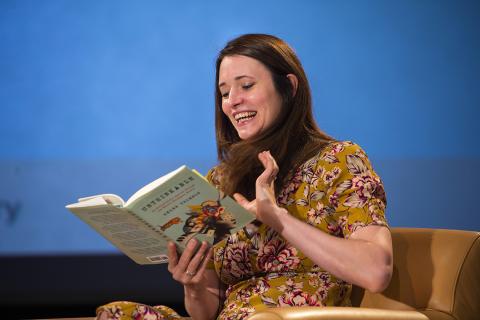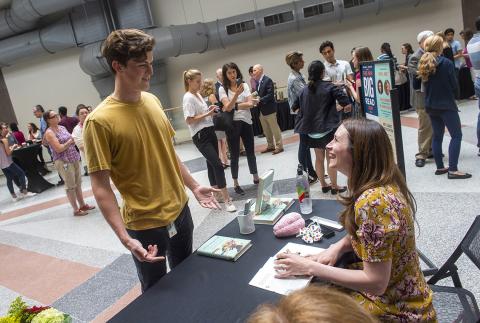‘Unthinkable’
‘Big Read’ Delves into Quirky Brains

Photo: Lisa Helfert
The brain can perform in unusual ways beyond our imagination that, in some cases, defy explanation.
Graham, for example, believed he was dead. Incredibly, an imaging scan while he was up and about confirmed low brain activity consistent with someone in a coma. Sylvia, meanwhile, never gets a moment’s peace because a continuous hallucination of musical notes plays in her head. And there’s Rubén, who perceives distinct colors when he sees people, hues that don’t exist for him in real life because he’s colorblind.
British author Helen Thomson explores these and other mind-boggling cases in her new book Unthinkable: An Extraordinary Journey Through the World’s Strangest Brains. On June 7, she visited NIH to converse with NIH director Dr. Francis Collins about the people with rare neurological conditions whom she met and interviewed for the book. Hundreds of NIH’ers joined them in Masur Auditorium for the 3rd annual Big Read, the culminating event following book club discussions around NIH.
Thomson, a freelance science journalist long fascinated with the brain, told the crowd that she started amassing peculiar case studies in medical journals and then reached out to the patients’ neurologists to learn more about these unusual conditions.
The first patient she met, Tommy, inspired her to write the book. On paper, Tommy had a stroke. After meeting him, she learned he’d been a convicted criminal with aggressive tendencies, but he emerged from the stroke with a different personality. The new Tommy was a docile, emotional bloke who took up poetry and painting.

Photo: Lisa Helfert
“You would never have known what your brain was capable of if you just read the journal article,” Thomson said. As the opportunity arose to meet more patients, she sought to talk with each subject almost as a friend, to learn about their daily lives and how they cope with their extraordinary brain conditions.
“I’m not a doctor so I didn’t want to approach these people from a clinical perspective in a hospital environment,” she said. “I wanted to specifically go and meet them in their towns, in their homes…Those are the kinds of stories that put brain disorders into context.”
When someone’s mental landscape goes awry, the patient usually first fears a brain tumor. “Part of the recovery for some of these people was finding out exactly what part of the brain was [affected],” said Thomson.
One patient, Sharon, gets lost everywhere, even in her own bedroom. She’s unable to form a mental map of her surroundings, Thomson writes in her book, because the areas in Sharon’s brain involved in navigation don’t communicate properly. Sharon discovered if she spins around—what she dubbed the Wonder Woman technique—her brain rights itself for a time, until its disorienting flip hours or days later.
Such stories might touch a nerve, as we see a little of ourselves in these people. “You talk about Sylvia, who has musical hallucinations where there’s an orchestra running through her head all the time. That’s me!” exclaimed Collins. “Maybe there is not a clear dividing line between the people you wrote about and the rest of us; they just have a more extreme version of something that’s part of many human personalities.”
Thomson agreed, noting that many people can relate on some level to Sharon’s plight of getting lost. “[These people] all had extreme versions of traits that we all possess,” she said.
One condition that appears in several people in Thomson’s book is synesthesia. About 4 percent of people worldwide have a mild form of this generally harmless trait that involves crossed senses. Rubén’s colorful auras, for instance, represent an extreme form of color-emotion synesthesia.

Photo: Lisa Helfert
“What I got out of meeting all these people,” Thomson said, “was the importance of talking about our perceptions of the world and understanding that what we see and feel and experience could be completely different to the person sitting next to us.”
Most of Thomson’s fact-finding missions were amiable, though one interview took an unexpected and frightening turn. When Thomson traveled to Abu Dhabi to meet Matar, his neurologist assured her that he was stable and eager to discuss his condition, called clinical lycanthropy. But unbeknownst to his doctors, Matar had recently stopped taking his medication. As Thomson sat beside Matar for the interview, he started to snarl and make clawing motions with his hands.
“There was this real internal battle,” said Thomson. “You could see he was really struggling to contain this delusion. Part of his mind was in this room with us and part of his mind was turning into a tiger.”
It takes talent to communicate science in an interesting, accessible way. When considering whether a science story is newsworthy, Thomson—who holds degrees in neuroscience and science communication—asks whether it meets at least one of these criteria: Is it new, is it relevant and is it something she’s excited to share with her friends?
She had intended to use more politically correct words to describe the patients she interviewed. “But it was doing a disservice to the people in the book to call their experiences atypical because that’s not how they described them to me,” she said. “It’s not ‘atypical,’ they’d say; ‘it’s really weird.’”
Rubén keeps a copy of the chapter about him to help explain his condition to friends. Sharon, who feared telling anyone of her condition for decades, now tells everyone, proudly displaying a Wonder Woman photo on her fridge. The others also eagerly shared their stories.
“They felt that the more information that was out there on these conditions, other people wouldn’t have to hide like they had,” Thomson said.
